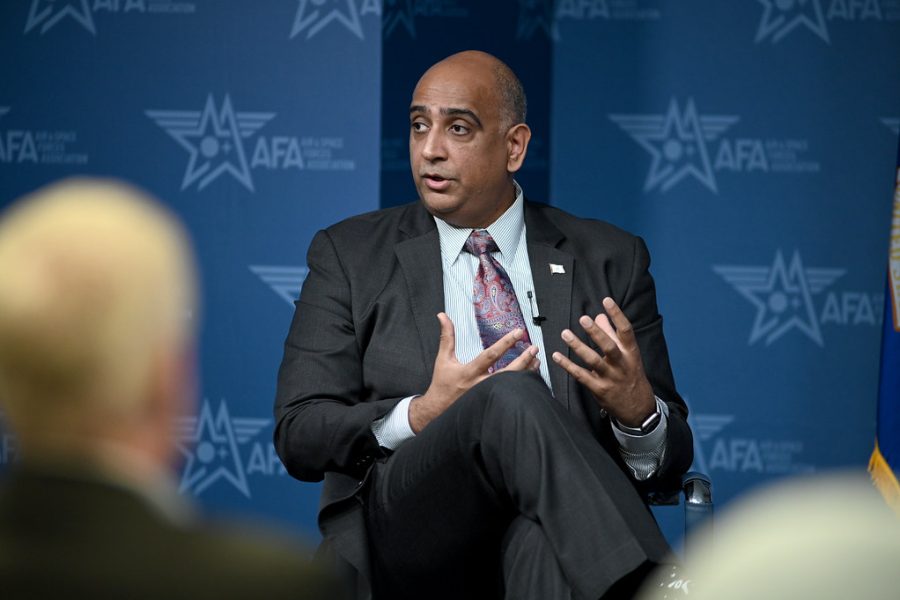Editor’s Note: This article has been updated to clarify Dr. Chaudhary’s comments that a microgrid kept the lights on at Kadena Air Base during a recent typhoon, not a microreactor. The article has also been updated to clarify that mobile microreactors are a separate effort from the microreactor being pursued at Eielson Air Force Base.
The Air Force is looking into a range of technologies, community partnerships, and third-party financing techniques to keep bases at home and downrange powered up in the event of bad weather or an attack by an adversary, the department’s installations czar said March 6. Geothermal energy, solar panels, miniature nuclear reactors, and more are all on the table as the service works to avoid losing power due to grid failures or fuel shortages.
“How much we can sustain the fight, fuel the fight, is going to drive our ability to sustain a great power competition,” Dr. Ravi Chaudhary, assistant secretary of the Air Force for energy, installations, and environment, said at an AFA Air & Space Warfighters in Action discussion.
“The cost of energy is not getting cheaper, nor is our ability to maintain reliability on our installations,” he added. “Working with industry, working with local power companies, working with local communities to establish third party methodologies, new ways of acquiring energy … is going to be critical.”
Many military installations overseas and at home rely on the electrical grids of their nearby communities, which are vulnerable to weather or enemy cyber attack.
“China’s hackers are positioning on American infrastructure in preparation to wreak havoc and cause real-world harm to American citizens and communities, if or when China decides the time has come to strike,” FBI Director Christopher Wray said in January to the House Select Committee on the Chinese Communist Party.
Hardening installations against that threat is one of Chaudhary’s top priorities, he said. One avenue could be to build microgrids that a base would power with solar panels, wind turbines, biomass, nuclear microreactors, and/or fossil fuel-powered generators. The idea is that if one source fails, the system overall can keep chugging. The Air Force is exploring geothermal plants at Joint Base San Antonio, Texas, and at F.E. Warren Air Force Base, Wyo.
Historically, solar, wind, and other forms of renewable energy have been viewed “as somewhat more frail,” Chaudhary said. “It’s exactly the opposite. By building redundancy into your installation in terms of power and energy … it’s like putting a power bar into your room because now you can plug in power sources that you want.”
A microgrid kept the lights on at Kadena Air Base, Japan, after a typhoon hit last year.
“That’s resiliency,” Chaudhary said. “That’s a ready base that, under any condition, can get the jets out of town and sustain the fight. That’s what we’re going to do more and more of.”
One promising source of power could be nuclear microreactors. The Pentagon is pursuing an effort called Project Pele, where microreactors small enough to fly aboard a C-17 could power forward bases. Separately, the Air Force plans to install a larger 5-megawatt microreactor at Eielson Air Force Base, Alaska, that will augment a 15-megawatt coal plant on base and shore up the installation’s independence from the local grid. The project has been slowed by contract issues, but Chaudhary expects it up and running in 2027.
The Air Force is going to “wait and see” how it goes at Eielson before trying the technology at other bases, the assistant secretary said. Meanwhile, other service branches and civilian stakeholders are looking to benefit from microreactors, which could present an opportunity for scientific and financial collaboration. For example, Kadena took advantage of an energy performance contract with the local community where the base used the energy savings from its LED lights to buy its microgrid.
“The best thing about this is that you can pursue a commercial license in parallel with the development and installation of the technology,” Chaudhary said. Usually the Air Force buys equipment, tests it, and then decides whether to license it to the wider market. “The business model to this is different: we’re going to pursue licensing from the get-go so that the entire state, the entire nation gets the benefit of this technology.”
A stronger microgrid could also allow a base to share energy with the local community, added Chaudhary. Later this spring, his office will release an Installation Infrastructure Action Plan that will have more details on making bases more resilient for fighting in a near-peer conflict.
While microgrids are a promising development for fixed installations, the Air Force wants mobility under a strategy called Agile Combat Employment, where small teams launch and recover aircraft from remote or austere locations and can move quickly to new airfields. Powering those locations could require a “hybrid” of energy sources, Chaudhary said.
Developing new solutions will take buy-in from industry, academia, and local communities, the assistant secretary said, and it has to happen fast.
“We can ill-afford to move at the speed of government when technology is moving at the speed of the threat,” he said.
